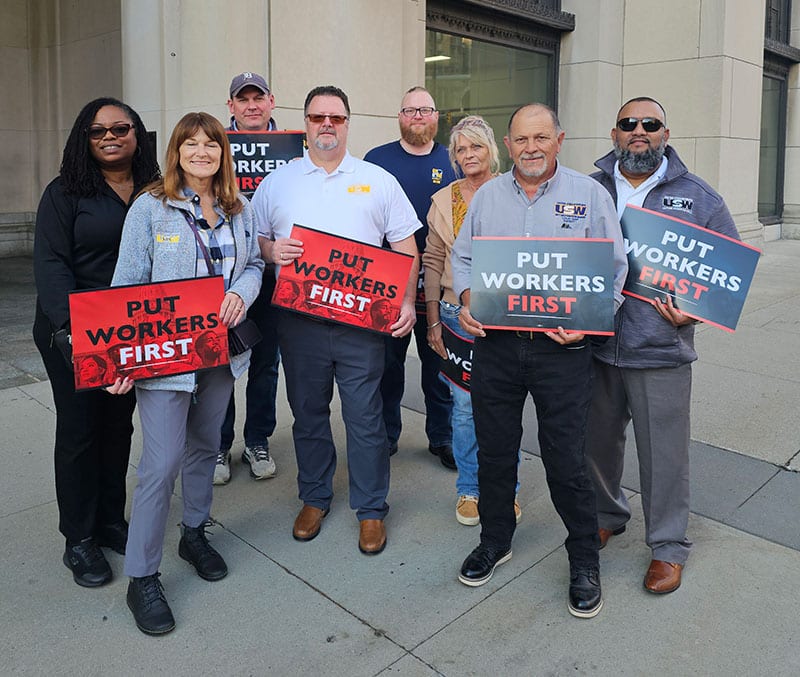Smooth Sailing: USW Members are the Backbone of Great Lakes Shipping Industry

For Ron Wilson and his fellow Local 5000 members, their USW co-workers are more than just union siblings. They are each other’s live-in family, seven days a week, for weeks – sometimes even months – at a time.
On board the huge Great Lakes shipping vessels that haul iron ore, salt, limestone and other materials to and from mines, factories and other destinations, Wilson and his co-workers take to the water for such long stretches that they forge an even closer bond with each other than most of their fellow Steelworkers can claim.
“It’s a lifestyle,” said Wilson, who serves as an able seaman. “You have to be willing to be a recluse. You’re in your own little bubble.”
That “bubble,” on board ships traversing the 94,000 square miles of Great Lakes, typically consists of about 20 union workers – 12 to 14 members of the USW and six to eight members of the Marine Engineers’ Beneficial Association, the labor union that represents the vessel’s deck and engine officers.
“It’s a family,” Wilson said. “We are a close-knit group. We have to be. We’re the only ones we’ve got out here.”
The Mark W. Barker
During one of his recent stints on land, Wilson joined members of his extended union family Sept. 1 on Cleveland’s lakefront to celebrate a historic event in the history of Great Lakes shipping. His employer, Interlake Steamship Co., was christening the Mark W. Barker (MWB), the company’s first new ship since 1981, and the first new U.S.-built cargo freighter on the Great Lakes since 1983.
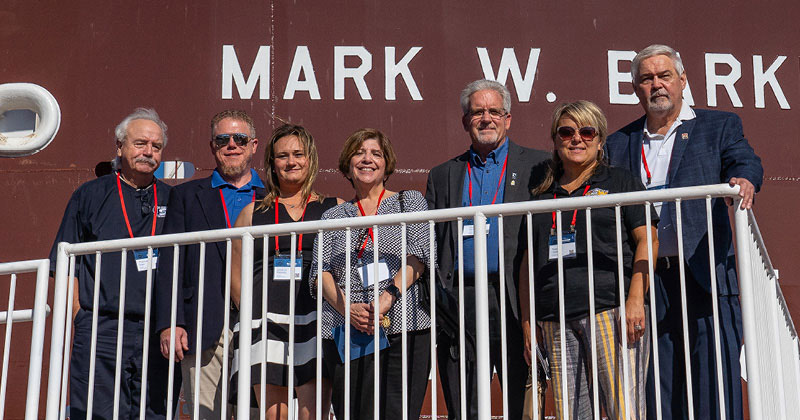
It was the type of ceremony many in the crowd of 700 invited guests had never had a chance to witness. The event included Interlake’s chairman James R. Barker and president (and namesake of the new ship) Mark W. Barker, as well as U.S. Rep. Marcy Kaptur, U.S. Rep. Shontel Brown and Cleveland Mayor Justin Bibb, all of whom spoke of the major contributions USW members make to Great Lakes shipping.
“To be a sailor on the Great Lakes takes guts,” said Kaptur, the longest-serving woman in Congress, whose district stretches across the southern shores of Lake Erie from Toledo to Cleveland. “To our friends in labor, who built and will crew this modern marvel – we value you.”
Also attending the ceremony was District 1 Director Donnie Blatt, who pointed out that the ship itself was built with USW-made steel, which was created from USW-mined iron ore, and finished with USW-made paint from Cleveland-based Sherwin-Williams.
“Thank you to our union members, who are truly the face of Interlake,” Mark Barker said. “Our employees are the heart and soul of our company.”
Prior to its christening, the ship had already made eight deliveries, including hauling ore from mines in Minnesota and Michigan to USW-represented mills across the Great Lakes.
“This ship has truly come full circle,” Blatt said. “Every piece of this ship, including the crew, is a testament to the hard-working members of our great union.”
A Unique Local
The 300 members of Local 5000 work not only on board the newly christened ship, but also on the other nine vessels in Interlake’s fleet, and nine other cargo carriers operated by companies including Central Marine Logistics and Key Lakes Inc.
The USW members who sail on the freshwater Great Lakes deliver and pick up cargo in Indiana, Illinois, Michigan, Minnesota, Ohio, New York, Pennsylvania, Wisconsin and parts of Canada.
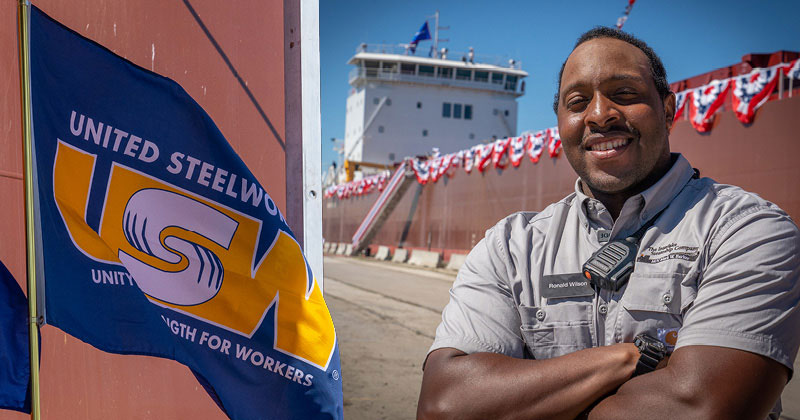
The life of a cargo ship crew member is unlike any other USW-represented job. Members don’t get to go home when their daily shifts end. They often miss weekends with their families, birthday parties, weddings and other important events.
The tradeoff, though, for a career in a family-supporting job that they love, is worth it. And the extended leave time during the off season, from late autumn to early spring when the weather is too cold to sail, helps to make up for the time away, members say.
“It’s not for everybody,” Wilson said of life working on the lakes.
Still, while USW jobs on the lakes require a deep commitment and significant time spent learning the ropes, they are “great jobs for someone right out of high school,” said Jayson Toth, Interlake’s director of training and vessel personnel.
“The ones that love it,” Toth said, “really love it.”
In addition to the good union wages and benefits, there’s a sense of pride that goes along with doing a job that contributes so much to the region’s economy, Wilson said.
“It’s a great feeling to be a part of something as big as this,” the six-year veteran sailor said. “There’s a lot to be proud of being a part of the Steelworkers. We are the bloodline of the steel industry, from the ground up.”
Modern Design
While the MWB is the smallest vessel in the Interlake fleet, because of its modern design, it can carry as much cargo as its larger sister ships. The vessel is 639 feet long with a cargo capacity of 26,000 tons. In addition to taconite, salt and stone, the MWB was designed to carry other material, such as wind turbine blades.
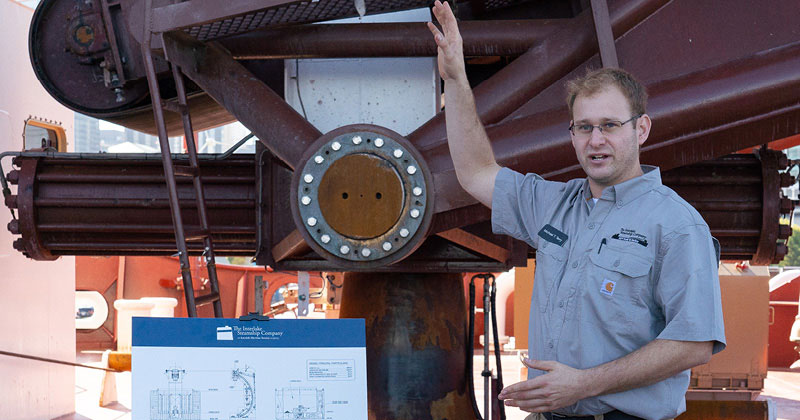
Constructed at Fincantieri Bay Shipbuilding in Sturgeon Bay, Wis., and powered by twin electro-motive diesel engines that generate 8,000 horsepower, the ship boasts fully computerized, touch-screen controls as well as a 2,000-horsepower loading and unloading system.
The vessel also adheres to the strictest environmental standards, as the first ship on the Great Lakes with engines that meet EPA Tier 4 emissions standards, adopted in an effort to significantly reduce pollution.
Compared to the other 40-plus-year-old vessels on the lakes, the MWB is “like night and day,” said ship Captain Paul Berger.
“The other boats are analog,” said First Mate Alex Weber. “This is digital.”
In addition, the combination of the smaller size and the increased maneuverability of the MWB, due to a more flexible rudder system, opens up some ports and narrow waterways that older, larger, less-nimble ships haven’t been able to reach.
All of those factors demonstrate why the MWB “represents the future of Great Lakes shipping,” the ship’s namesake declared.
The shipping industry contributes about $35 billion annually to the region’s economy, and supports nearly 150,000 jobs in the Great Lakes area. With looming investments in infrastructure and strong Buy American laws in place, those numbers will only grow, Barker said.
Source of Pride
From the Cleveland-Cliffs workers in Minnesota’s iron range who mined the iron ore, to those at the Burns Harbor mill in Indiana who made the steel needed to build it, to the crewmembers from all across the country who help keep the Interlake fleet moving, all USW members should be proud of the MWB and of their roles in the region’s economy, Barker said.
“It’s amazing how many touch points the USW has had on this boat,” Barker said. “We are part of the fabric of the industrial aspect of this nation.”
The MWB not only represents the recent resurgence of American manufacturing, he said, but also of a return to waterway shipping, which is among the most efficient ways to move cargo.
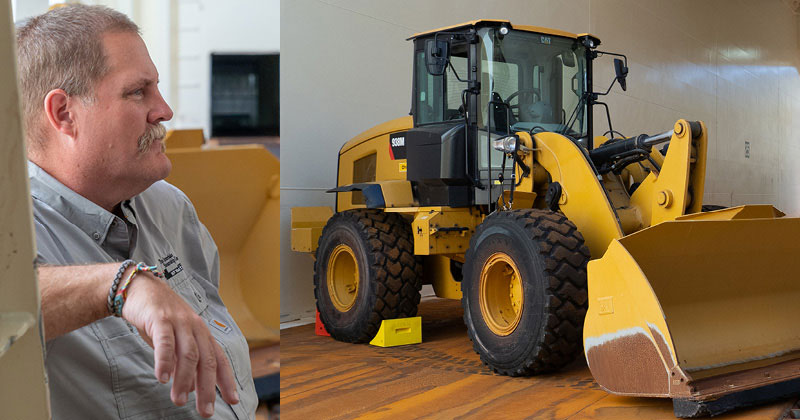
Jones Act Benefits
One reason why the MWB was built in the United States, with USW-made materials, is because of a 102-year-old piece of federal legislation known as the Jones Act. Part of the Merchant Marine Act, the law stipulates that any ship transporting goods between U.S. ports must be U.S.-flagged and U.S.-built, with a strong preference for American workers as crew members.
That’s just fine with Barker, who said he is proud of his family-owned company’s role in providing good jobs for U.S. workers.
“We saw so much offshoring in the 1980s,” Barker said. “It was a shame, but now we’re starting to see the onshoring again.”
That means good jobs for USW members and other workers across all industries, Barker said, and because ships that sail on freshwater lakes can last longer than ocean liners, the outlook for the Great Lakes shipping industry, and those that it supports, is strong.
“We are looking long-term,” Barker said. “There is a need for U.S. shipping on the lakes, and we stand ready to meet those needs.”
By clicking Sign Up you're confirming that you agree with our Terms and Conditions.
Recent News Articles
Want to Learn More?
See how the USW is making a real difference in our communities and our workplaces.

